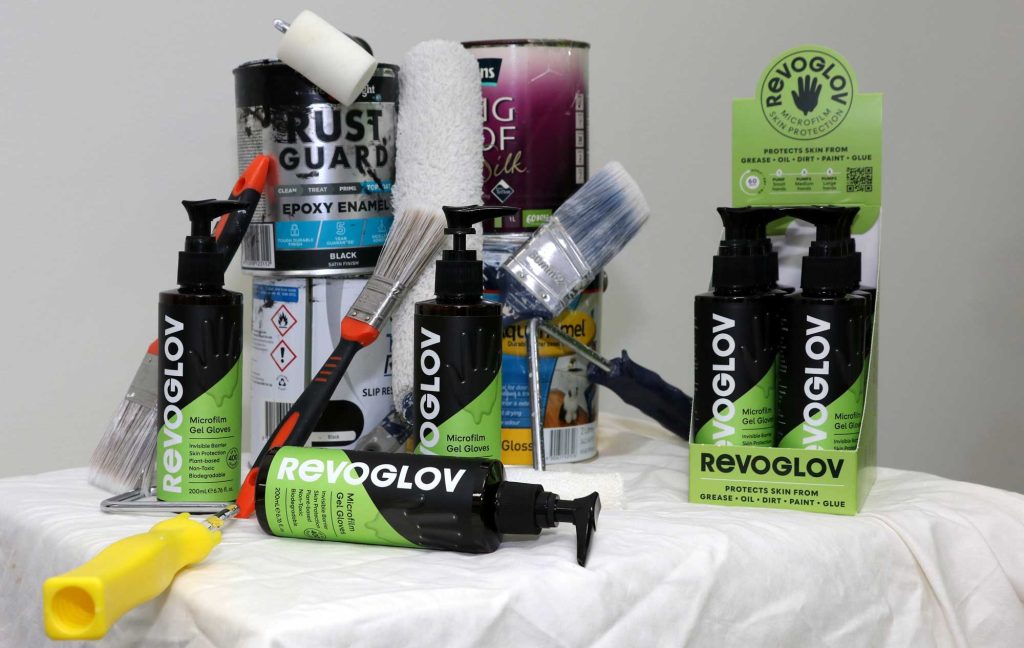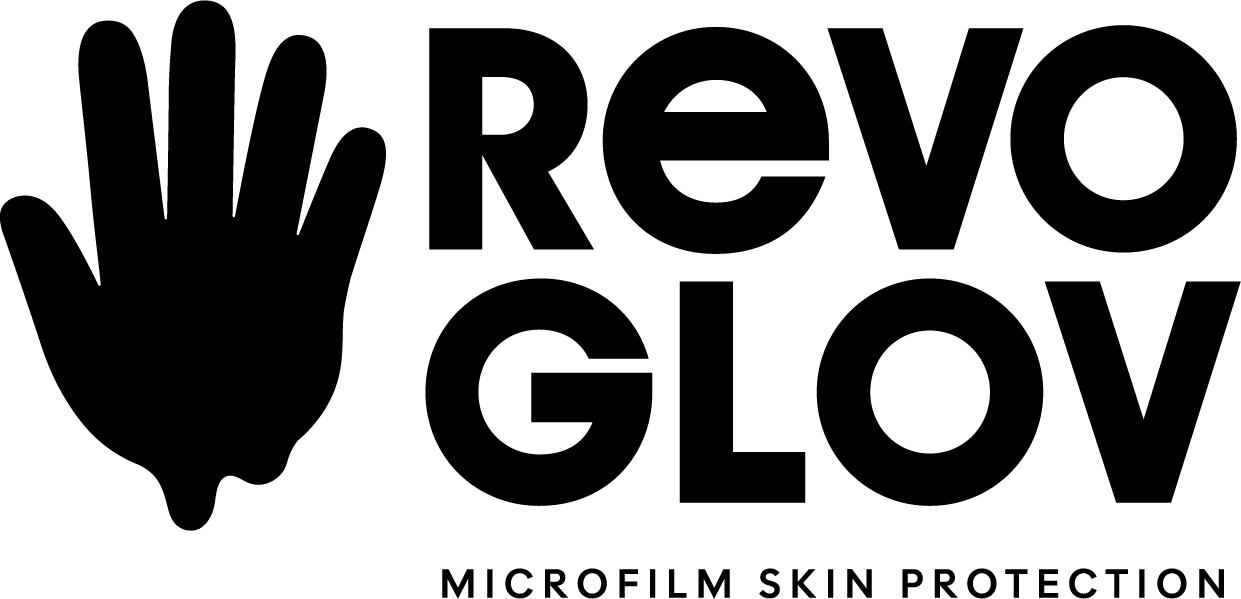RevoGlov: Biodegradable Hand Protection for Construction Environments
The construction industry faces two concurrent priorities that increasingly overlap: ensuring occupational safety and reducing environmental impact.
Protective equipment is crucial for worker health, but most disposable items—especially gloves—add to landfill waste and deplete resources. Every day, thousands of nitrile or latex gloves are used once and then thrown out.
This conflict between safety compliance and environmental responsibility has created a need for new materials that maintain protection standards while lowering waste.

A Western Australian development known as RevoGlov seeks to address this intersection and to offer increased protection against contaminants for workers who cannot wear gloves but are exposed to contaminants
The product is a pump-on, biodegradable polymer coating that provides temporary hand protection without relying on single-use gloves.
Its design goal is to keep dexterity, hygiene, and easy removal while decomposing naturally after use. A Perth-based materials scientist developed the material to reduce reliance on synthetic disposable gloves in low- to moderate-risk work environments.
Product Description
RevoGlov is a spray-applied polymer barrier that forms a flexible, micro-thin film on the skin. Once applied, the coating dries within seconds and creates a surface layer intended to protect against water, dust, light oils, mild detergents, and incidental abrasion.
The membrane can be removed by regular hand-washing.
The company describes three key design characteristics:
- Tactile precision – the film conforms closely to the skin and allows regular grip and finger movement.
- Environmental performance – the polymer is biodegradable and designed not to generate microplastic residues.
- Operational efficiency – one application can last for several hours, reducing the need for frequent glove changes during specific tasks.
RevoGlov is designed for tasks with low chemical or mechanical risk, where traditional gloves might hinder fine manual handling.
Context: Limitations of Conventional Gloves
Disposable nitrile, latex, and vinyl gloves are standard on most construction sites.
They provide a certain level of protection but also have practical and environmental drawbacks.-
- Dexterity constraints during detailed work such as wiring, painting, or adhesive application.
- Heat build-up and perspiration, leading some workers to remove gloves intermittently.
- High turnover, resulting in large quantities of waste.
- Low recyclability, as contamination prevents reprocessing.
The combined outcome is a continuous cycle of use and disposal that increases both material cost and environmental burden.
RevoGlov is designed to supplement, rather than replace, these gloves—reducing usage frequency in lower-risk operations while maintaining compliance with safety protocols.
Intended Applications in Construction
There are several occupational contexts where RevoGlov may be used as an alternative or supplementary barrier.
1. Painting and Surface Finishing
Tasks involving water-based paints, primers, or sealants often require multiple glove changes to avoid contamination.
RevoGlov can be applied directly to the hands to prevent mild skin irritation from these materials while allowing unrestricted movement for detailed finishing.
For solvent-based coatings, certified chemical-resistant gloves remain necessary; RevoGlov can serve as an inner barrier to maintain hygiene beneath them.
2. Tiling and Adhesive Work
Adhesives, grouts, and silicones can cause dermatitis with prolonged exposure. The RevoGlov membrane creates a physical barrier that reduces direct contact with these substances.
Because the coating is thin and breathable, it allows for the precise placement of tiles or joint compounds without the bulk of disposable gloves.
3. Electrical, Mechanical, and Fit-Out Tasks
Light mechanical and electrical work demands tactile accuracy.
The product is suitable for low-impact assembly tasks—such as cable routing or hardware installation—where protection is needed but high-level cut resistance isn’t necessary. It can also be worn under reusable gloves to minimise friction and moisture build-up.
4. Cleaning and Site Maintenance
The coating provides short-term resistance to splashes and light contact with water or mild detergents, allowing use during brief cleaning or maintenance tasks before reapplication is required.
When applied under reusable gloves, it helps minimise internal contamination and prolongs the gloves’ lifespan.
5. General Skin Protection
Cement dust, lime, oils, and surface contaminants often cause dry or irritated skin.
Regular use of RevoGlov creates a protective film that helps maintain skin condition without affecting tool grip or sensitivity.
Functional Parameters
The manufacturer outlines several measurable characteristics for performance assessment:
| Parameter | Specification or Intent |
| Durability | Maintains protective function for several hours under normal site conditions; reapplication recommended after heavy abrasion or repeated washing. |
| Chemical Resistance | Suitable for mild acids, alkaline detergents, and water-based products. Not intended for exposure to concentrated solvents, fuels, or corrosives. |
| Permeability | Allows heat and moisture exchange to reduce perspiration. |
| Biodegradation | Decomposes into non-toxic by-products; no microplastic residue. |
| Compatibility | Can be used independently or as a sub-layer beneath certified gloves. |
Formal laboratory testing for compliance with Australian PPE and EN standards (chemical permeation and abrasion resistance) is in progress. Until certification is complete, use should remain within the manufacturer-defined low-risk parameters.
Environmental and Economic Considerations
Waste Reduction
Gloves represent a significant component of construction waste streams. By substituting a portion of disposable glove use with a spray-on barrier, firms can reduce plastic waste volumes and the associated disposal costs.
Because RevoGlov is biodegradable, any residual material that enters landfill will break down naturally rather than persist.
Material Efficiency
Refillable spray units replace single-use glove packaging, cutting logistics needs and reducing on-site storage space. Lower glove turnover and waste volumes are expected to deliver additional economic benefits over time.
Sustainability Alignment
The product’s biodegradability supports alignment with environmental management frameworks such as Green Star, WELL Building, and ISO 14001.
Incorporating RevoGlov into procurement and sustainability reporting allows construction firms to show practical efforts toward circular material use and lowering single-use plastic consumption.
Implementation Considerations
The adoption of RevoGlov in construction environments depends on integration with existing safety management systems.
Key factors include:
- Regulatory compliance – verification through independent testing and certification before substitution in PPE inventories.
- Worker training – instruction on correct application, coverage, and reapplication intervals to maintain barrier integrity.
- Environmental conditions – assessment of film performance under humidity, dust, or temperature extremes to determine site suitability.
- Task categorisation – defining specific work activities where the product can safely replace or supplement disposable gloves.
- Documentation – inclusion in Safe Work Method Statements, risk assessments, and site induction materials.
A controlled pilot within specified task groups can gather operational data on product lifespan, waste minimisation, and worker acceptance without compromising safety compliance.
Role Within Safety Systems
RevoGlov should be seen as an engineering control supplement rather than a complete PPE replacement.
Its best role is in:
- Tasks with low mechanical hazard,
- Situations where frequent glove replacement currently occurs, and
- Contexts where environmental sustainability objectives are a corporate priority.
Integration should always be done in consultation with safety officers to ensure alignment with jurisdictional OHS legislation and site PPE hierarchies.
Potential Advantages
- Reduced waste generation through lower glove consumption.
- Improved dexterity for detailed or precision work.
- Enhanced user comfort due to breathable film properties.
- Simplified hygiene management, especially when used as an under-glove barrier.
- Alignment with sustainability frameworks, providing measurable ESG reporting value.
Identified Limitations
- Limited chemical and puncture resistance, unsuitable for heavy-duty or high-risk tasks.
- The importance of consistent training to ensure complete coverage during application.
- Potential variation in performance under adverse environmental conditions.
Recognition of these boundaries is essential for responsible use and accurate performance evaluation.
Outlook
The introduction of biodegradable barrier coatings, such as RevoGlov, demonstrates how material innovations can help achieve both safety and sustainability goals in construction. If certification verifies current design claims, the product could become part of a broader range of low-impact protective technologies that supplement, rather than replace, conventional PPE.
For the construction sector, which must continually balance safety standards, operational costs, and environmental responsibility, RevoGlov offers a scientifically developed approach to hand protection. It is designed to maintain functional performance while reducing the environmental impact associated with single-use gloves.
Its ongoing development reflects a broader trend in materials science—using biodegradable chemistry in everyday industrial processes to minimise waste without compromising safety standards.
Frequently Asked Questions
What is RevoGlov made from?
A proprietary biodegradable polymer formulation designed to decompose without producing microplastic residues.
Is RevoGlov certified?
RevoGlov is currently undergoing independent laboratory testing for compliance with relevant Australian and international PPE standards, but has not yet received formal certification.
Which construction tasks are suitable?
Painting, finishing, cleaning, and other low-exposure tasks that do not involve sharp objects or concentrated chemicals.
Does RevoGlov replace all gloves?
No. Certified gloves remain mandatory for mechanical, electrical, or chemical hazards above the manufacturer’s stated tolerance.
How is RevoGlov removed?
By regular washing with water.
Key Points
- RevoGlov is a biodegradable, spray-on hand-protection coating developed in Western Australia.
- It is designed for low-risk construction tasks where glove waste and dexterity loss are common.
- The polymer forms a temporary barrier against mild contaminants and abrasion.
- It reduces single-use glove waste and aligns with environmental certification frameworks.
- Broader adoption depends on formal PPE certification and site-specific validation.
Primary sources:
National Builders Guide (2025). Perth scientist creates biodegradable “gloves in a bottle” for construction.
RevoGlov (2025). For Business: Industrial hand-protection and sustainability solutions. https://revoglov.com/for-business/
